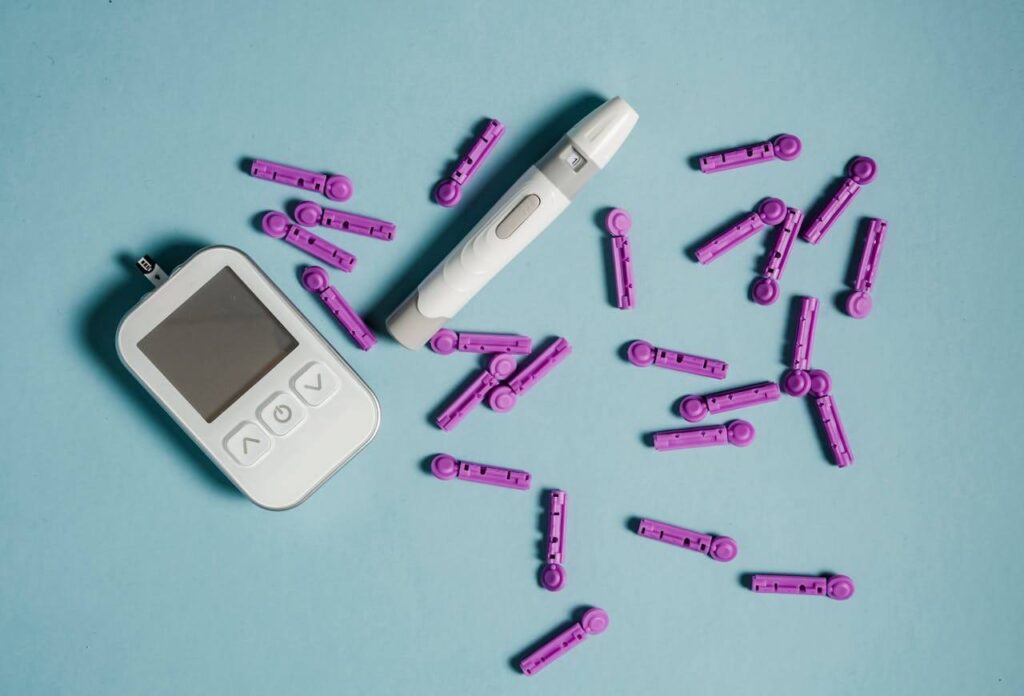Does your energy and mood feel all over the map? Your blood sugar may be the culprit. Blood sugar imbalance can take your energy levels and mood on a roller coaster ride. High blood sugar (aka hyperglycemia) also increases the risk of a slew of health issues, like diabetes, heart disease, kidney issues, and more.
But here’s the good news. Many simple diet and lifestyle tweaks can help you regain blood sugar balance. Whether you’re diabetic, prediabetic, or simply want to enhance your health, read on to learn 13 natural ways to reduce your blood sugar.
Tips to Lower Your Blood Sugar
1 – Move your body

Exercise helps just about everything, including your blood sugar. When you move your body, the muscle contractions help burn glucose. Exercise also increases insulin sensitivity. Meaning, it helps your cells use the sugar in your bloodstream better.
In fact, according to the American Diabetes Association, exercise can lower your blood sugar for up to 24 hours post-workout.
Shoot for 150 minutes of physical movement each week to keep your blood sugar in check. Dance, bike, swim, lift weights, play tennis, or take a hike. Anything to get your body moving!
2 – Watch your carbs
Your body breaks down carbohydrates into sugar (glucose), which provides energy to your cells. As glucose enters your bloodstream, your blood sugar spikes.
Some carbs spike your blood sugar quicker than others. Foods with added sugars like cookies and candy can cause dramatic blood sugar spikes. The same goes for refined carbs like white bread, white pasta, and white rice. That’s why limiting starchy, high-sugar foods is a must for blood sugar balance.
However, that does mean you need to nix carbs altogether! Just opt for complex carbs like sweet potatoes, brown rice, oatmeal, and lentils. These foods are not only nutrient-dense, but they’re also high in fiber – so they raise your blood sugar more slowly.
3 – Don’t eat carbs “naked”
Another good rule of thumb for blood sugar regulation is to not eat carbs solo. Instead, try pairing them with protein or fat (or both!). Protein and fat both slow the digestion of carbohydrates. Meaning, they help reduce the blood sugar spikes from eating carbs.
For example, if you’re eating an apple, have it with almond butter. Since almond butter has
protein and fat, it’ll help lessen the blood sugar spike from the apple.

4 – Bump up fiber
Fiber, like protein and fat, slows the digestion of carbs and glucose absorption. Meaning, fiber promotes a more gradual rise in blood glucose. Studies even show eating a high-fiber diet can improve blood sugar regulation in people with diabetes.
Soluble fiber, in particular, is shown to improve blood sugar regulation. Eating more fruits and veggies in general can increase your soluble fiber intake.
But here are some foods that are particularly high in soluble fiber:
- Brussels sprouts
- Sweet potatoes
- Carrots
- Avocadoes
- Pears
- Apples
- Flaxseed
- Oats
5 – Monitor your blood sugar

Glucometers have become quite trendy these days, and for good reason. These devices give you a peek at your glucose levels to see how your blood sugar reacts to certain foods (and even stress).
This can help build awareness so you can make adjustments to keep your blood sugar more balanced. For example, if you notice a blood sugar spike after you have a big bowl of pasta, you may want to have a smaller portion next time. Or consider trying a lower-carb option like spaghetti squash or zucchini noodles.
6 – Go for a walk after meals
Taking a post-meal walk is one of the easiest ways to lower your blood sugar. Moving your muscles after meals helps clear glucose from your bloodstream. And you don’t need to take a long stroll to see the benefits.
One 2022 study found that walking for just 2-5 minutes can help balance your blood sugar. So a little can go a long way!
7 – Keep stress in check

Stress can wreak havoc on your blood sugar. When you’re stressed out, your body releases hormones like cortisol and glucagon. As these hormones rise, so does your blood sugar. And if stress lingers for too long, it may increase the risk of diabetes.
Luckily, studies also show that stress management techniques can help balance your blood sugar. One study found relaxation tools like exercise and meditation reduced stress and blood glucose levels in nursing students.
So find ways to ease your stress, whether that be through yoga, mindfulness, deep breathing, or spending time in nature. Your blood sugar will thank you.
8 – Eat carbs last
Eating carbs last is another simple way to tame the blood sugar spike from meals. Research shows eating vegetables and protein before carbs can blunt the blood sugar spike from a meal by over 50%!
According to the Glucose Goddess, the most blood-sugar-friendly way to enjoy a meal is vegetables first, protein second, and carbs last.
To see graphs of this principle in action, check out the Glucose Goddess’ Instagram.
9 – Drink plenty of water

Hydration is crucial to keep your blood sugar steady. Your kidneys depend on water to flush out excess glucose in your urine. This may explain why people who drink more water are less likely to develop high blood sugar issues like type 2 diabetes.
While water can help lower your blood sugar levels, other drinks like soda and juice can raise blood glucose. So pass on the sugary drinks and stick to water instead.
10 – Don’t forget fermented foods
Fermented foods are best known for their gut-loving properties. They replenish your gut with friendly bacteria, which benefits your digestion, immune system, and even your blood sugar.
Studies show consuming fermented foods can help slow the digestion of carbs. Meaning, adding fermented foods to your meals may lead to lower blood sugar levels post-meal.
Fermented foods to add to the menu include sauerkraut, kimchi, yogurt, kefir, tempeh, miso, and kombucha.
11 – Take a shot of ACV
Want a quick way to lower blood sugar? Take a swig of apple cider vinegar (ACV). A 2021 review found consuming ACV regularly led to lower blood glucose levels.

ACV slows the digestion of carbs. The slower carbs are digested, the easier it is on your blood sugar. This means that when ACV is taken with meals, it may reduce the blood sugar spike afterward.
Fair warning: ACV has a strong taste and is quite acidic. So it’s best to dilute it with water. To try this tip out, mix 1-2 tablespoons of ACV in a glass of water and drink it before meals.
12 – Get enough sleep
Skimping on sleep can throw off your blood sugar. Studies show lack of sleep impairs glucose metabolism and decreases insulin sensitivity. Plus, cortisol levels rise when you’re low on sleep. As mentioned, when cortisol levels stay high, it can keep your blood sugar high too.
Most health experts say to aim for at least 7-8 hours of sleep every night. If getting quality sleep is a challenge, here are a few tips that may help upgrade your sleep:
- Avoid caffeine for 8 hours before bed.
- Stick to a consistent sleep schedule.
- Limit or avoid screens for 1-2 hours before bed.
- Create a relaxing bedtime routine to prepare for sleep. Journal, read, take a bath, do some gentle stretches, or try a guided meditation.
- Keep your bedroom dark, quiet, and cool.
13 – Maintain a healthy weight
Keeping your weight in a healthy range promotes blood sugar balance and reduces the risk of diabetes. That said, losing weight is often easier said than done. The good news is that even small reductions in body weight can be enough to see improvements.
Research shows losing just 5% of your body weight can be enough to improve blood sugar regulation. For example, let’s say you weigh 200 pounds. Losing as little as 10 pounds may help balance your blood sugar levels.
Balance Your Blood Sugar & Lose Weight With Shape ReClaimed in the Chicago Area
The tips we’ve covered can go a long way in helping you lower your blood sugar. That said, change (even healthy change) can be overwhelming without the right support.
So if you live in the Chicago area and could use some guidance to bring your blood sugar or weight to a healthier spot, we’re here for you.
At Anchored in Health, we offer the Shape ReClaimed program – a healthy lifestyle restoration plan that can help:
- Balance your blood sugar
- Promote weight loss
- Reduce inflammation
- Enhance immune function
- Detox your body
- And much more…
To learn more about how Shape ReClaimed works and how it can help you achieve your health goals, check out this article.
Or contact us to find out how this weight loss program can help you balance your blood sugar and lose weight in a healthy, sustainable way.
Other Wellness Services Offered at Anchored in Health in Orland Park, IL
Anchored at Health is committed to helping you and your loved ones live their healthiest lives. That’s why we offer a variety of holistic health services to help you feel your best including functional medicine, chiropractic care, acupuncture, and massage therapy. We even offer functional assessments like genetic testing and thermography.
Contact us to find out how we can help you reach your health goals and regain your vitality.
Disclaimer: The information provided on this blog is for educational and informational purposes only and is not intended to diagnose, treat, cure, or prevent any disease. The content is not a substitute for professional medical advice, diagnosis, or treatment. Always seek the guidance of a qualified healthcare provider with any questions you may have regarding your health or a medical condition.
Reading this blog does not establish a doctor-patient relationship between you and Anchored In Health or any of its practitioners. Reliance on any information provided in this blog is solely at your own risk. For medical concerns, always consult a licensed healthcare provider.
References
- https://diabetes.org/health-wellness/fitness/blood-glucose-and-exercise
- https://pubmed.ncbi.nlm.nih.gov/1663443/
- https://www.ncbi.nlm.nih.gov/pmc/articles/PMC4950069/
- https://link.springer.com/article/10.1007/s40279-022-01649-4
- https://www.ncbi.nlm.nih.gov/pmc/articles/PMC5319684/
- https://pubmed.ncbi.nlm.nih.gov/25540518/
- https://www.ncbi.nlm.nih.gov/pmc/articles/PMC5604719/
- https://pubmed.ncbi.nlm.nih.gov/34186361/
- https://www.ncbi.nlm.nih.gov/pmc/articles/PMC8878449/
- https://link.springer.com/article/10.1186/s12906-021-03351-w
- https://pubmed.ncbi.nlm.nih.gov/16227462/
- https://www.ajmc.com/view/stress-hormone-cortisol-associated-with-increased-blood-sugar-in-t2d-population
- https://pubmed.ncbi.nlm.nih.gov/34749892/
